Magento vs Shopify: Key Highlights on Product, Inventory, Marketing & Order Management Features

Welcome to the only Magento vs Shopify comparison you need to understand what platform works best for your business. In the world of eCommerce, choosing between Magento and Shopify is often a matter of scale, customization, and ease of use. Both platforms are highly popular but cater to different types of businesses.
Magento is an open-source platform designed for flexibility and scalability. It allows for deep customization, making it ideal for large enterprises or businesses with specific needs. However, this comes with complexity — it requires a development team and technical knowledge to manage effectively.
Shopify, on the other hand, is a fully hosted solution known for its simplicity and ease of use. It allows businesses of all sizes to launch a store quickly, without technical expertise. Shopify is perfect for small to medium-sized businesses looking for a streamlined setup process with minimal configuration.
In this Magento vs Shopify comparison, we’ll look at product management, inventory management, marketing, and order management to help you decide which platform suits your business needs.

Table of contents
Product Creation and Management: Magento vs Shopify
When you start an e-commerce business, your first task is to fill in your digital storefront with products. Let’s compare Magento vs Shopify to see what core features in this area they offer.
Product Types and Complex Configurations
Magento’s ability to handle a wide range of product types makes it a flexible solution for businesses with complex catalogs. The platform supports simple, configurable, bundled, grouped, downloadable, virtual, and gift card (only in Adobe Commerce) products.

This variety is essential for businesses with products that come in multiple variations, like different colors, sizes, or even custom configurations. With Magento, you can leverage configurable products to link multiple variants under a single parent product. This feature helps with inventory management and simplifies the user experience.
Shopify, on the other hand, focuses on simplicity. Shopify supports physical, digital, and service-based products, but it doesn’t offer the same depth of product type management as Magento.

While Shopify does support variants like color and size, it’s not built for the same level of custom attribute handling. This makes Shopify a great choice for small and medium-sized businesses that don’t need to manage complex product catalogs but want to get their products online quickly.
SKU Management and Product Categorization
Magento provides powerful SKU management, enabling each product variation to have its own unique SKU. This allows for precise inventory control, especially for businesses managing large inventories across multiple locations.
Magento also supports hierarchical product categorization, letting businesses create nested categories with multiple levels of subcategories, which is helpful for large catalogs.
Shopify also supports SKU management but in a simpler format. While each variant can have a unique SKU, Shopify doesn’t support hierarchical categories in the same way Magento does. Shopify uses collections to organize products, and while effective for smaller stores, it’s not as robust as Magento’s category system for large-scale businesses.
Customizable Product Pages
Magento excels with its customizable product pages, allowing businesses to create dynamic layouts that can be fully tailored using custom templates. This is important for companies that want to create unique shopping experiences for different product lines.
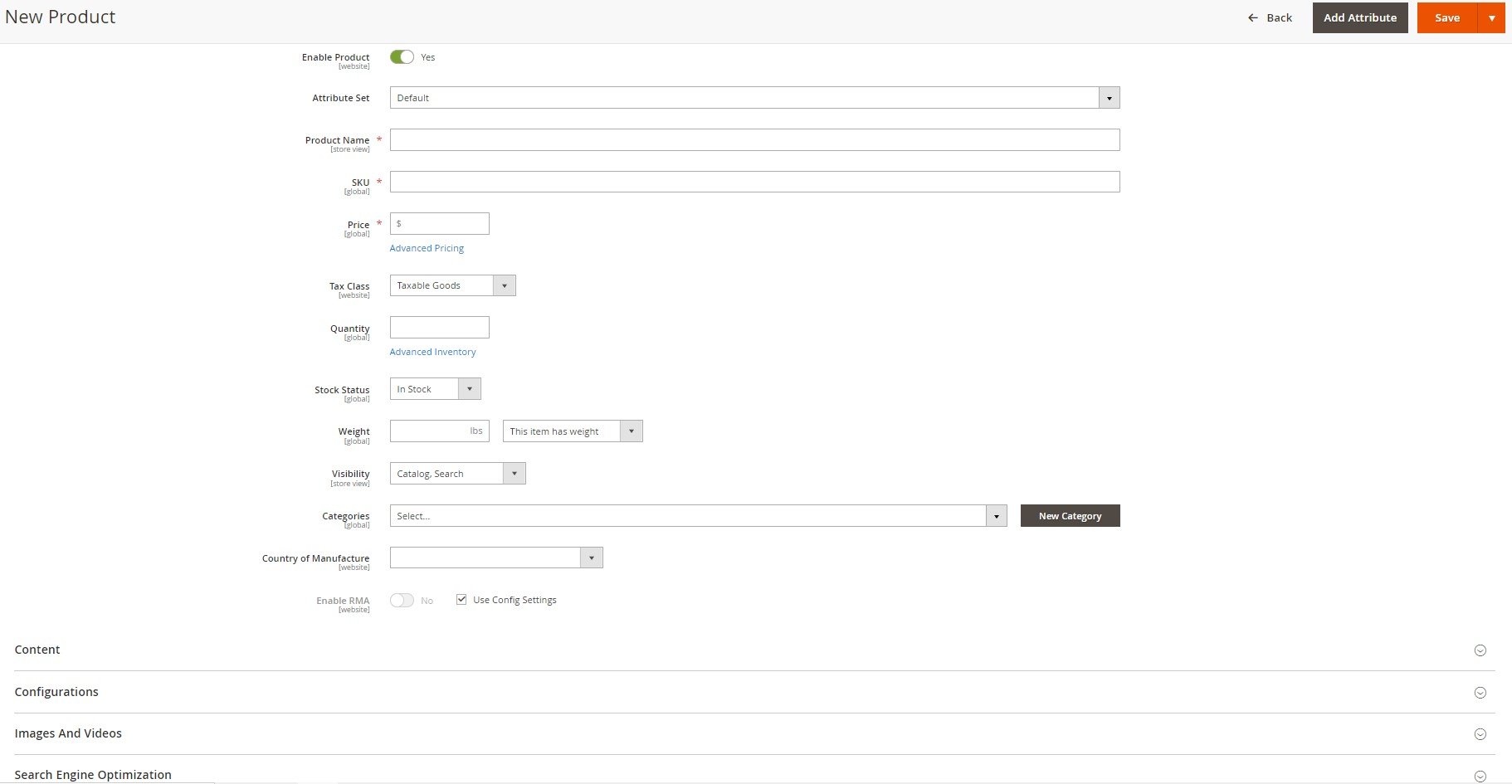
The platform also supports rich media, allowing businesses to embed videos, high-resolution images, and other custom content directly on product pages to enhance the shopping experience.
Shopify’s product page customization is easier to implement but more limited in scope. It offers a wide range of pre-built themes, and businesses can customize these to some extent using Shopify’s built-in tools.
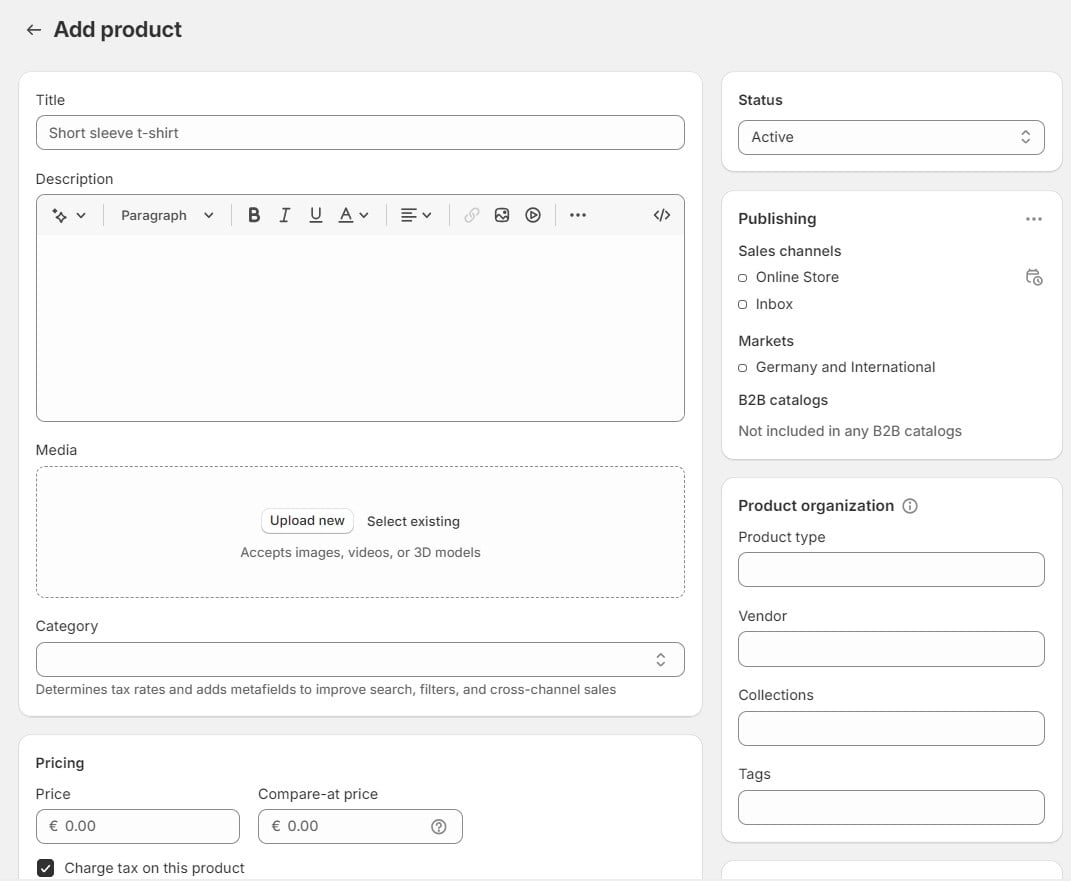
However, Shopify lacks the deep flexibility of Magento’s templating system, which may be a drawback for businesses that need complete control over the look and feel of their product pages.
The following table compares Magento vs Shopify from the perspective of the essential product features:
| Feature | Magento | Shopify |
| Product Types Supported | Simple, configurable, bundle, grouped, downloadable, virtual, gift cards | Physical, digital, service-based, gift cards |
| SKU Management | Unique SKUs for all product variations | Basic SKU tracking for product variants |
| Product Categorization | Hierarchical categories with subcategories | Collections for product organization |
| Product Page Customization | Fully customizable with templates | Pre-built themes with basic customization |
| Bulk Product Import | CSV/XML with extensive control | CSV for basic product data |
Inventory Management: Magento vs Shopify
When your product catalog is ready, you need to take care of the inventory duties. Let’s compare Magento vs Shopify to see what’s available in this niche.
Multi-Source Inventory vs Multi-Location Inventory
Magento’s Multi-Source Inventory (MSI) feature enables businesses to manage stock across multiple warehouses, fulfillment centers, and retail stores. This feature allows businesses to allocate stock to specific locations, prioritize shipments based on stock availability, and even optimize order fulfillment by selecting the closest fulfillment center.

This advanced system is ideal for businesses that operate globally or across multiple locations, giving them granular control over where their inventory is stored and how it’s distributed.
Shopify also offers multi-location inventory management, which allows businesses to track inventory across multiple locations, such as warehouses or retail stores.
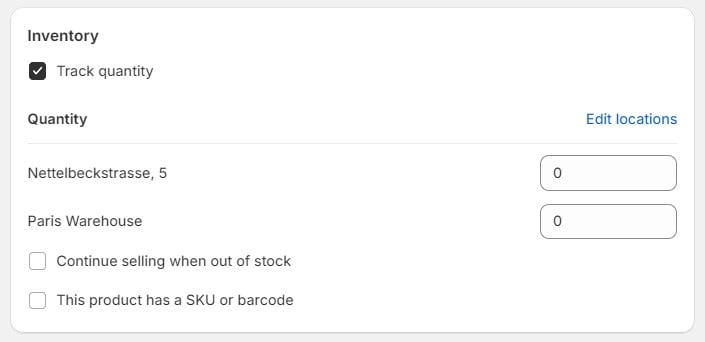
However, Shopify’s multi-location management is simpler than Magento’s MSI, focusing on basic stock allocation and fulfillment. Shopify automatically updates stock levels as sales occur, making it a good fit for smaller businesses or those with simpler inventory needs.
Now, let’s move forward in our Magento vs Shopify comparison and take a closer look at inventory forecasting.
Inventory Forecasting and Reporting
Magento provides advanced inventory forecasting tools, allowing businesses to anticipate future stock needs based on historical sales data. This helps merchants ensure they don’t run out of stock during peak periods and improves overall stock management.
In addition to that, Magento’s detailed inventory reports give insights into stock movement, inventory levels, and product performance.
Shopify also offers inventory reporting, though it’s more basic than Magento’s system. Shopify provides stock-level reports and low-stock notifications but lacks the in-depth forecasting tools that Magento provides.
Shopify users can access essential data to maintain healthy stock levels but may need third-party apps for more advanced forecasting.
Batch Inventory Updates
Magento’s batch inventory management capabilities are highly advanced, allowing for bulk updates across multiple locations and product types via CSV or XML imports. Businesses can update thousands of SKUs in one go, making Magento ideal for large-scale operations.
Besides, it supports multi-location updates, meaning you can modify stock levels across various warehouses with ease.
Shopify also supports batch inventory updates, but the functionality is simpler. Businesses can update stock levels using CSV imports, but Shopify’s system doesn’t support as many custom fields as Magento’s. While it works for straightforward inventory updates, it lacks the flexibility needed for more complex operations.
The following table compares Magento vs Shopify to highlight their essential inventory management capabilities:
| Feature | Magento | Shopify |
| Multi-Location Inventory | Advanced Multi-Source Inventory (MSI) | Simple multi-location tracking |
| Inventory Forecasting | Advanced forecasting and reporting tools | Basic reporting with third-party apps for advanced features |
| Batch Inventory Updates | Bulk updates via CSV/XML across multiple locations | Basic CSV bulk updates |
| Low-Stock Notifications | Customizable notifications based on thresholds | Automatic low-stock alerts |
Marketing: Shopify vs Magento
What’s the next thing after product catalog and inventory management? It’s marketing! You need to promote your products.
When it comes to eCommerce marketing, both Magento and Shopify offer a suite of tools designed to help businesses attract and engage customers, drive conversions, and optimize marketing campaigns. However, the platforms differ in the depth and flexibility of their features. In this section, we’ll compare Magento vs Shopify across the key categories of marketing features: Promotions and Discounts, SEO, Email Marketing, Customer Segmentation, Retargeting and Abandoned Cart Recovery, Analytics and Reporting, etc.
Promotions and Discounts
Magento offers highly customizable rule-based promotions, allowing businesses to create discounts triggered by specific conditions such as customer groups, cart content, product attributes, or total order value.
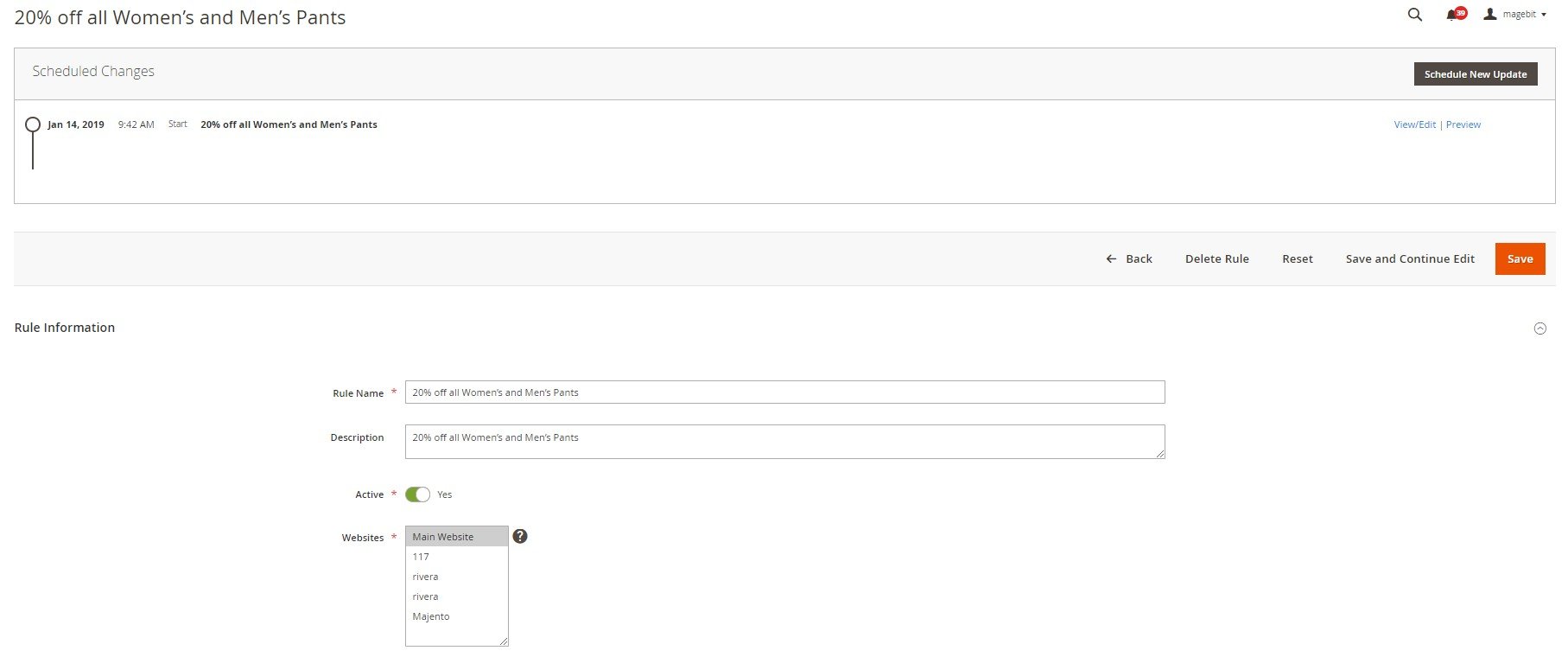
Magento’s flexibility lets merchants design complex promotional strategies, including multi-tiered discounts, “Buy X, Get Y” offers, or customer-specific promotions. This is especially useful for enterprises that need to handle numerous customer segments or product categories and want to offer tailored promotions.
Shopify, in comparison, focuses on simplicity with its built-in discounts and coupon codes. Shopify supports percentage-based discounts, fixed discounts, and free shipping offers, which can be applied automatically at checkout based on predefined conditions.
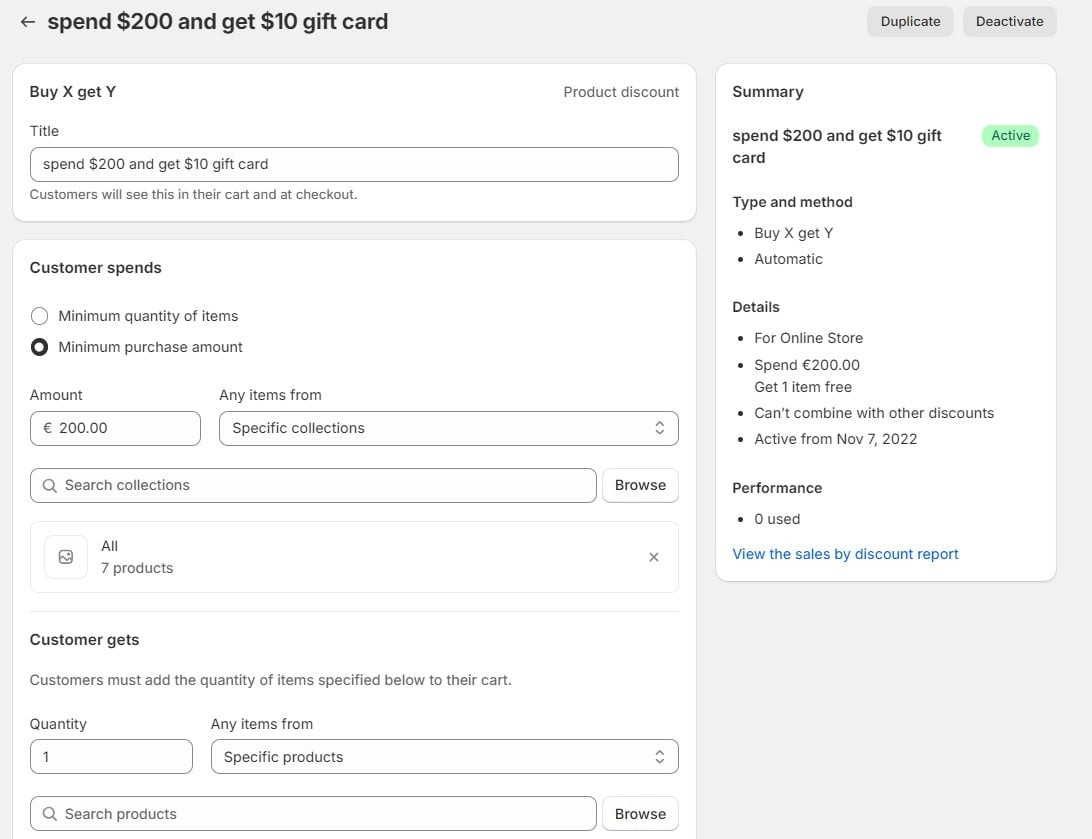
While Shopify’s system is easier to use, it lacks the advanced customization and complexity of Magento’s rule-based discount system. Shopify’s discount features are perfect for small businesses looking for quick and easy promotional setups without custom configurations.
SEO
Magento is known for its advanced SEO tools. Merchants have full control over every aspect of Magento SEO, including custom meta titles, meta descriptions, SEO-friendly URLs, canonical tags, and even structured data like rich snippets. It also supports XML sitemaps and allows for URL rewrites, giving merchants control over how their pages are indexed by search engines. This makes Magento a great platform for businesses that require deep control over their SEO strategies and need to optimize large product catalogs for search engines.
Shopify offers more basic SEO tools, but they’re designed to be user-friendly and accessible to merchants without technical expertise. Shopify automatically generates SEO-friendly URLs and sitemaps, and merchants can easily edit meta titles, descriptions, and alt text for images.
While Shopify ensures a solid SEO foundation, it doesn’t provide the same granular level of control that Magento offers. However, for smaller stores, Shopify’s built-in SEO tools are more than adequate to drive traffic from search engines.
Email Marketing
Magento doesn’t have a built-in email marketing tool but integrates seamlessly with a wide range of third-party email marketing platforms such as Mailchimp, Klaviyo, and Dotdigital. This flexibility allows businesses to choose the platform that best fits their email marketing needs.
Shopify, on the other hand, offers its built-in email marketing tool, Shopify Email, which allows businesses to create, send, and track email campaigns directly from the Shopify admin.
Shopify Email comes with pre-designed templates for newsletters, promotions, and product launches, making it a good option for small to medium-sized businesses that want a simple solution.
Shopify also integrates with platforms like Mailchimp and Klaviyo for more advanced email marketing needs.
Customer Segmentation
Magento excels in customer segmentation, offering advanced tools that allow businesses to group customers based on behavior, demographics, purchase history, and other attributes. This granular control enables merchants to tailor marketing campaigns, discounts, and personalized recommendations to different customer groups, leading to more targeted and effective marketing efforts.

Magento’s ability to segment customers based on complex conditions is particularly beneficial for large businesses that want to deliver personalized experiences.
Shopify, in turn, offers basic segmentation capabilities through customer tags, filters, and rules. While the platform lets you group customers based on certain criteria, such as order history or tags, it doesn’t provide the advanced segmentation features available in Magento. However, Shopify’s simpler approach works well for businesses that don’t need deep customer targeting and want an easy way to differentiate between customer groups for marketing purposes.
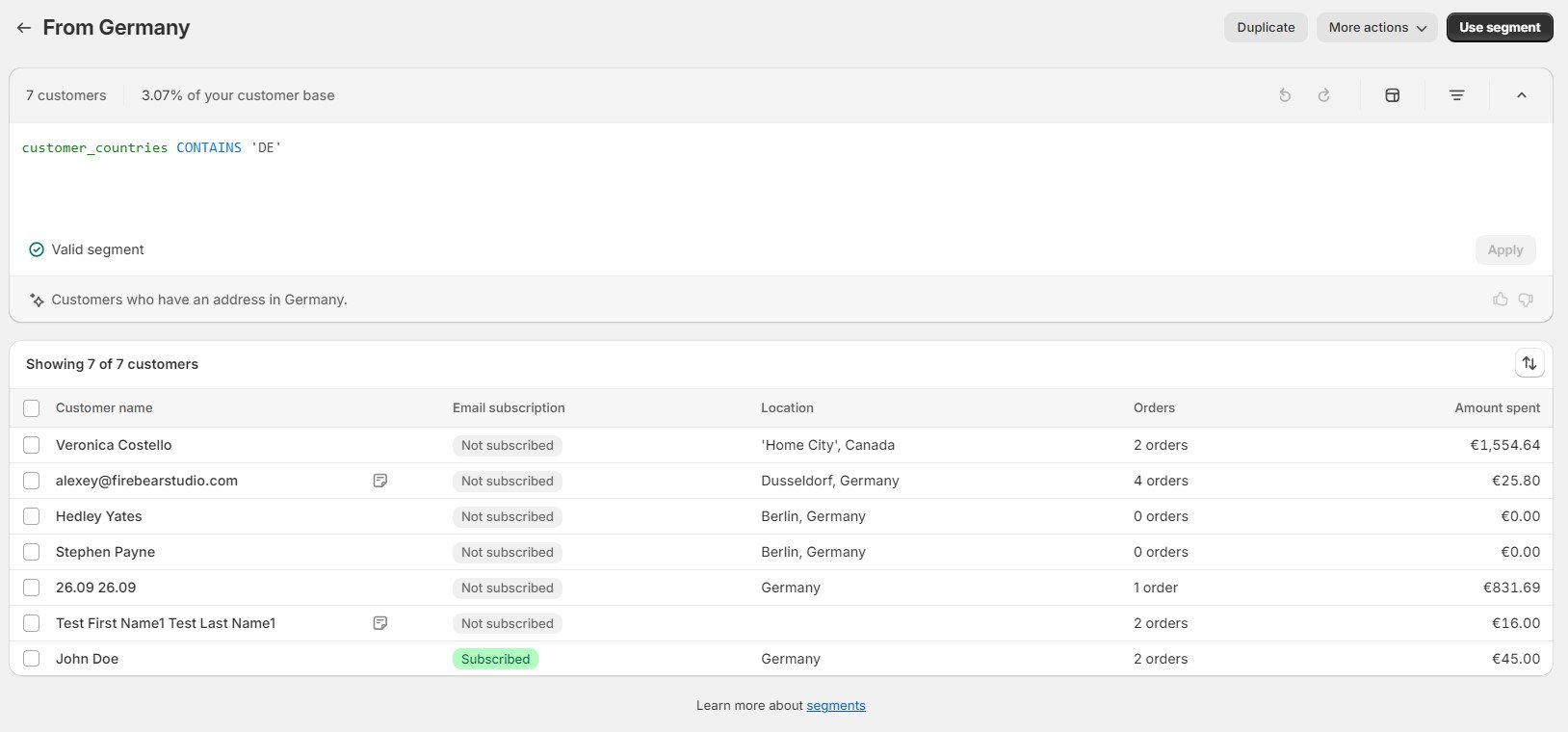
Retargeting and Abandoned Cart Recovery
Magento offers abandoned cart recovery through extensions and third-party integrations. Merchants can set up automated email campaigns to remind customers of their abandoned carts with personalized product recommendations based on browsing behavior.
Shopify, by contrast, has a built-in abandoned cart recovery system, which automatically sends reminder emails to customers who leave products in their cart without completing a purchase. This feature is easy to use and can be set up with just a few clicks, making it a great option for small businesses.
Additionally, Shopify integrates with Facebook and Google Ads, allowing businesses to create retargeting campaigns across these platforms.
Analytics and Reporting
Magento provides extensive reporting and analytics tools that allow businesses to track everything from customer behavior and product performance to marketing campaign effectiveness. The platform’s built-in reports cover sales, customer segmentation, product performance, and abandoned cart recovery, giving businesses valuable insights into their marketing efforts.
Additionally, Magento integrates with Google Analytics for even more detailed data tracking, including conversion funnels and traffic sources.
Shopify, however, is not that powerful. It offers a simplified analytics dashboard that provides insights into customer activity, sales performance, and basic marketing metrics. Shopify’s reports are easy to understand and ideal for small businesses that don’t need in-depth analytics.
For more advanced tracking, Shopify integrates with Google Analytics and other third-party tools, allowing merchants to measure the success of their marketing campaigns and optimize their strategies accordingly.
Influencer Marketing
Shopify distinguishes itself in this Magento vs Shopify comparison with a unique feature called Shopify Collabs – a tool that integrates influencer marketing directly into the platform. This feature enables merchants and influencers to collaborate easily, allowing businesses to leverage the reach of social media personalities to promote their products.
With Shopify Collabs, businesses can discover and partner with influencers, track sales generated through influencer campaigns, and manage payments — all within Shopify’s ecosystem. This tool simplifies influencer marketing, making it accessible even to small businesses that may not have experience with such strategies.

In contrast, Magento does not have a built-in solution for influencer marketing. While Magento’s flexibility allows businesses to integrate third-party tools to manage influencer campaigns, it requires additional effort in terms of setup and management.
Businesses using Magento would need to rely on external platforms for influencer discovery, sales tracking, and partnership management. This adds complexity and potential costs, especially for businesses that don’t have a dedicated marketing team to manage these integrations.
Ultimately, Shopify Collabs offers a streamlined and integrated approach to influencer marketing, giving Shopify an edge in this area. Magento, while highly customizable, lacks a native solution for this growing marketing trend, making it less convenient for businesses looking to explore influencer collaborations.
| Feature | Magento | Shopify |
| Promotions and Discounts | Advanced rule-based promotions, highly customizable | Simple discount codes and automatic discounts |
| SEO Optimization | Full control over SEO (meta tags, URLs, rich snippets) | Basic SEO tools with auto-generated URLs and meta tags |
| Email Marketing | Third-party integrations (Mailchimp, Klaviyo) | Built-in Shopify Email, with additional integrations |
| Customer Segmentation | Advanced segmentation for targeted marketing | Decent segmentation with customer tags, filters, and rules |
| Abandoned Cart Recovery | Customizable recovery via extensions | Built-in abandoned cart recovery emails |
| Customer Retargeting | Integrates with third-party platforms for custom retargeting | Built-in integration with Facebook and Google Ads for retargeting |
| Analytics and Reporting | Detailed analytics with custom reporting | Basic analytics, integrates with Google Analytics |
| Influencer Marketing | Third-party tools and marketing teams are required | Native Shopify Collabs functionality. |
Order Management: Magento vs. Shopify
Once your first sale is complete, the next crucial step is managing your orders efficiently. In the following section, we compare Magento vs Shopify to highlight the essential features each platform offers in the realm of order management. Understanding how each platform handles this aspect is key to ensuring smooth fulfillment processes and maintaining customer satisfaction.
Order Processing Workflows
Magento allows businesses to create custom order processing workflows, which can be tailored to specific needs such as splitting orders across multiple warehouses, handling partial shipments, or setting up advanced return processes. This level of flexibility is perfect for enterprises with complex logistics and fulfillment needs.

Magento also supports backorders and allows businesses to customize how they handle out-of-stock products, ensuring a seamless experience for customers even when inventory is low.
Shopify’s order management system, as you might have already guessed, is designed for simplicity and ease of use. The platform enables admins to process orders from an intuitive dashboard, print shipping labels, and send automatic notifications to customers at various stages of fulfillment.

While Shopify doesn’t offer the same level of customization in order workflows as Magento, it’s highly efficient for small to medium-sized businesses that don’t need complex logistics.
Automated Shipping and Fulfillment
Magento integrates with multiple shipping carriers, allowing businesses to set up custom shipping rules based on location, weight, and delivery times. It’s essential if you need to offer different shipping options to customers based on their location or the nature of the products they’ve ordered.
Magento also allows businesses to automate fulfillment by integrating with third-party logistics providers.
As for Shopify, it offers integrated shipping solutions too but focuses on simplicity. Shopify users can print shipping labels directly from the dashboard, choose from a range of shipping carriers, and automatically calculate shipping rates at checkout. While its shipping tools are more basic than Magento’s, they are ideal for businesses looking for a straightforward solution to manage their logistics without the need for custom rules.
| Feature | Magento | Shopify |
| Order Processing | Advanced custom workflows (split orders, partial shipments) | Simple and efficient order processing |
| Automated Shipping | Multiple shipping integrations with custom rules | Integrated with built-in shipping carriers |
| Order Notifications | Customizable notifications at all stages | Automatic notifications for key events |
| Backorder Management | Yes, with customizable backorder settings | Basic backorder support |
Final Thoughts: Magento vs Shopify
Both Magento and Shopify are powerful eCommerce platforms, but they are designed to serve different types of businesses with varying needs.
Magento stands out for its customizability, scalability, and ability to manage complex business operations. It is ideal for large enterprises or businesses that require advanced control over product catalogs, inventory, and order management workflows. Magento’s marketing capabilities, particularly in customer segmentation and SEO optimization, also make it a good choice for companies looking for detailed control over their marketing strategies.
However, Magento’s complexity means that it often requires a dedicated technical team or developer, making it less suitable for smaller businesses without these resources.
Shopify, on the other hand, excels in ease of use and quick setup. It is perfect for small to medium-sized businesses or those just starting who prioritize simplicity over customization. Shopify’s built-in features, such as Shopify Collabs for influencer marketing and its intuitive order management tools, allow businesses to manage operations without needing extensive technical expertise.
Shopify’s user-friendly interface, along with its integration of essential marketing tools like Shopify Email, makes it an attractive option for businesses looking to grow their online presence without the hassle of complex configurations.
Shared Limitations and Solutions: One notable limitation of both platforms is their lack of built-in automation for import/export processes and robust data mapping capabilities. This can be challenging for businesses managing large inventories or complex data structures.
Fortunately, Firebear offers solutions for both Magento and Shopify that address these issues. Firebear’s Improved Import & Export Magento 2 extension and Import & Export Tool for Shopify provide businesses with the ability to automate these processes, ensuring that data flows seamlessly between systems while offering customizable mapping capabilities.
In conclusion:
- Magento is best suited for large enterprises and businesses requiring deep customization, advanced marketing features, and control over complex operations.
- Shopify is the ideal platform for small to medium-sized businesses that value ease of use, quick setup, and integrated marketing tools.
The choice between Magento vs Shopify depends on your specific business needs and growth strategy. With the right tools and integrations like Firebear offers, both platforms can be optimized to handle the most challenging aspects of eCommerce management.









